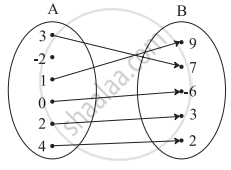Advertisements
Advertisements
प्रश्न
If \[f\left( x \right) = 64 x^3 + \frac{1}{x^3}\] and α, β are the roots of \[4x + \frac{1}{x} = 3\] . Then,
पर्याय
(a) f(α) = f(β) = −9
(b) f(α) = f(β) = 63
(c) f(α) ≠ f(β)
(d) none of these
उत्तर
(a) f(α) = f(β) = −9
Given:\[f\left( x \right) = 64 x^3 + \frac{1}{x^3}\]
\[\Rightarrow f\left( x \right) = \left( 4x + \frac{1}{x} \right)\left( 16 x^2 + \frac{1}{x^2} - 4 \right)\]
\[\Rightarrow f\left( x \right) = \left( 4x + \frac{1}{x} \right)\left( \left( 4x + \frac{1}{x} \right)^2 - 12 \right)\]
\[\Rightarrow f\left( \alpha \right) = \left( 4\alpha + \frac{1}{\alpha} \right)\left( \left( 4\alpha + \frac{1}{\alpha} \right)^2 - 12 \right)\text{ and } f\left( \beta \right) = \left( 4\beta + \frac{1}{\beta} \right)\left( \left( 4\beta + \frac{1}{\beta} \right)^2 - 12 \right)\] Since α and β are the roots of \[4x + \frac{1}{x} = 3\] \[4\alpha + \frac{1}{\alpha} = 3 \text{ and } 4\beta + \frac{1}{\beta} = 3\] \[\Rightarrow f\left( \alpha \right) = 3\left( \left( 3 \right)^2 - 12 \right) = - 9\] and \[f\left( \beta \right) = 3\left( \left( 3 \right)^2 - 12 \right) = - 9\] \[\Rightarrow f\left( \alpha \right) = f\left( \beta \right) = - 9\]
APPEARS IN
संबंधित प्रश्न
A function f : R → R is defined by f(x) = x2. Determine (a) range of f, (b) {x : f(x) = 4}, (c) [y: f(y) = −1].
Write the domain and range of \[f\left( x \right) = \sqrt{x - \left[ x \right]}\] .
Let f and g be two functions given by
f = {(2, 4), (5, 6), (8, −1), (10, −3)} and g = {(2, 5), (7, 1), (8, 4), (10, 13), (11, −5)}.
Find the domain of f + g
If f(x) = cos (log x), then the value of f(x2) f(y2) −
If \[f\left( x \right) = \frac{2^x + 2^{- x}}{2}\] , then f(x + y) f(x − y) is equal to
The domain of the function
The domain of definition of \[f\left( x \right) = \sqrt{4x - x^2}\] is
If f(x) = `{(x^2 + 3"," x ≤ 2),(5x + 7"," x > 2):},` then find f(3)
Which of the following relations are functions? If it is a function determine its domain and range:
{(1, 1), (3, 1), (5, 2)}
Check if the following relation is a function.

If f(m) = m2 − 3m + 1, find f(−3)
Find the domain and range of the following function.
f(x) = `sqrt(16 - x^2)`
Express the following exponential equation in logarithmic form
54° = 1
Express the following exponential equation in logarithmic form
3–4 = `1/81`
Express the following exponential equation in logarithmic form
e2 = 7.3890
Express the following logarithmic equation in exponential form
log10 (0.001) = −3
Express the following logarithmic equation in exponential form
ln e = 1
Write the following expression as sum or difference of logarithm
In `[(root(3)(x - 2)(2x + 1)^4)/((x + 4)sqrt(2x + 4))]^2`
If f(x) = 3x + 5, g(x) = 6x − 1, then find (fg) (3)
Select the correct answer from given alternatives
The domain of `1/([x] - x)` where [x] is greatest integer function is
Answer the following:
Identify the following relation is the function? If it is a function determine its domain and range.
{(2, 1), (4, 2), (6, 3), (8, 4), (10, 5), (12, 6), (14, 7)}
Answer the following:
If f(x) = 3x + a and f(1) = 7 find a and f(4)
Answer the following:
If f(x) = ax2 + bx + 2 and f(1) = 3, f(4) = 42, find a and b
Answer the following:
Let f : R → R be given by f(x) = x + 5 for all x ∈ R. Draw its graph
Answer the following:
Find x, if x = 33log32
Given the function f: x → x2 – 5x + 6, evaluate f(x – 1)
A function f is defined by f(x) = 2x – 3 find x such that f(x) = x
The domain of the real valued function f(x) = `sqrt((x - 2)/(3 - x))` is ______.
Find the range of the following functions given by f(x) = |x − 3|
Redefine the function f(x) = x − 2 + 2 + x , – 3 ≤ x ≤ 3
If f(x) = `(x - 1)/(x + 1)`, then show that `f(1/x)` = – f(x)
If f(x) = `(x - 1)/(x + 1)`, then show that `f(- 1/x) = (-1)/(f(x))`
The domain and range of the function f given by f(x) = 2 – |x – 5| is ______.
The domain of the function f(x) = `1/sqrt(|x| - x)` is ______.
Which of the following functions is NOT one-one?
If f : R – {2} `rightarrow` R i s a function defined by f(x) = `(x^2 - 4)/(x - 2)`, then its range is ______.
lf f : [0, ∞) `rightarrow` [0, ∞) and f(x) = `x/(1 + x)`, then f is ______.
